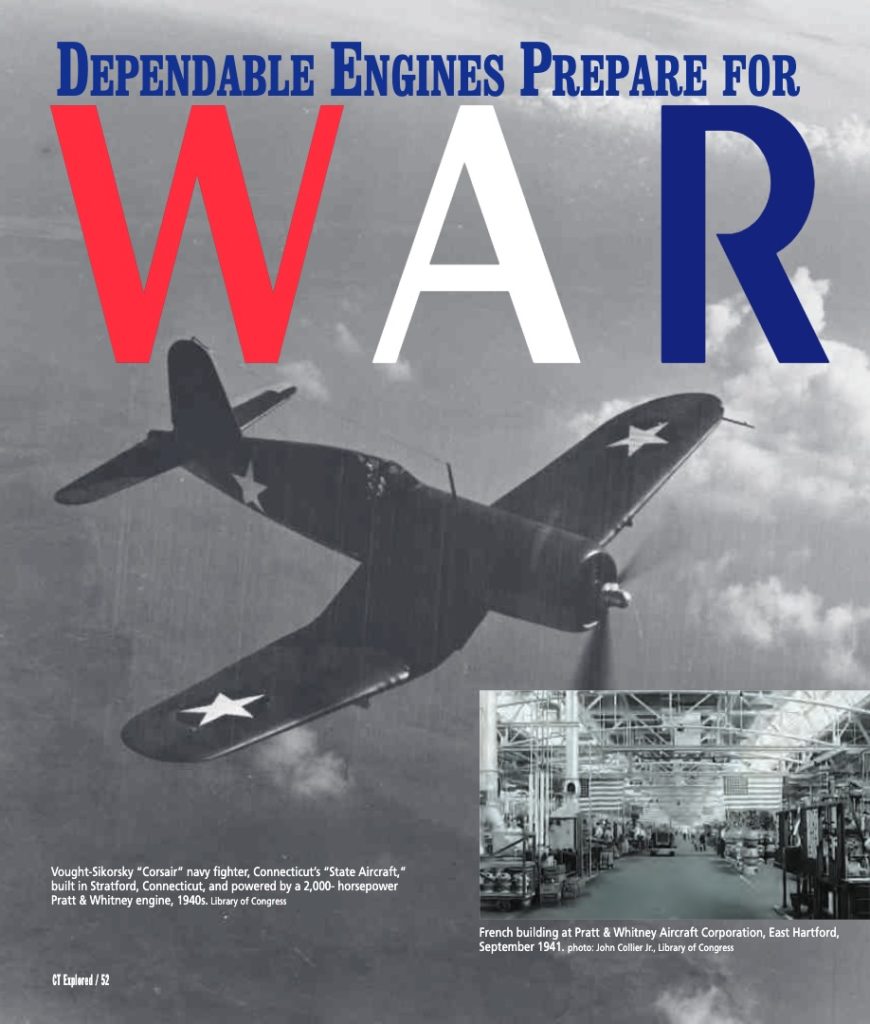(c) Connecticut Explored Inc. Fall 2020
Subscribe/Buy the Issue!
When Frederick B. Rentschler moved to Hartford in 1925 to start the Pratt & Whitney Aircraft Company (P&W), his goal was to transform the struggling American aviation industry into a technologically advanced, efficiently managed, profitable enterprise that would rival the then world-leading European aviation industry. According to Mark P. Sullivan in Dependable Engines: The Story of Pratt & Whitney (Library of Flight, 2008), by 1929 Pratt & Whitney’s air-cooled “dependable engines” (as the company logo asserts) were the choice of both the United States Navy and the emerging commercial airline industry. The industry itself was largely shaped by the new United Aircraft & Transport Company (UA&TC)—an aviation conglomerate that included P&W and of which Rentschler was founding president. With sales of $31.5 million and profits of $8.3 million that year, UA&TC claimed in its first annual report to occupy “possibly the strongest position in the aeronautical field of any company in the world.”
The Great Depression, however, sent Pratt & Whitney’s fortunes in an entirely different direction. Military budget cutbacks, unsuccessful research and development initiatives, and contract losses to competitors were compounded by U. S. Senate hearings in 1934 concerning the awarding of extremely lucrative airmail contracts that made the aviation industry, and leaders such as Rentschler, appear to be gouging the U.S. Treasury at a time when many Americans went hungry.
President Roosevelt canceled all airmail contracts, and the commercial aviation industry went into a tailspin. The situation at Pratt & Whitney was bleak. By fall 1938, the company had only enough orders to keep the plant open until the following May, after which it would face laying off 3,000 workers.
What saved the company, albeit indirectly, was a conference that September in Munich, Germany between Adolph Hitler and the leaders of France, Britain, and Italy. Led by British Prime Minister Neville Chamberlain, who infamously claimed the concession would bring “peace in our time,” the group gave in to Hitler’s demands to allow him to annex the Sudetenland from Czechoslovakia. Returning from the conference, French Premier Edouard Deladier said, “If I had had 4,000 planes, there would have been no Munich.”
France, which had been the world aviation leader, by 1938 had fallen deeply behind in both airplane production and technology. Realizing that war with Germany was inevitable, the French government placed a $2 million order for Pratt & Whitney aircraft engines before the year ended, followed by additional orders totaling $85 million within a year.
P&W was now scrambling to meet demand. The company doubled its workforce, hiring 3,000 new workers, and built a 280,000-square-foot expansion to its East Hartford plant in only four months in 1939, using funds provided by the French government.
Britain soon followed the French lead, placing its own order for P&W engines shortly after Winston Churchill became prime minister in May 1940. After France fell to the Nazis a month later, the British assumed France’s remaining engine orders and financed construction of a new 425,000-square-foot expansion at Pratt & Whitney.
President Roosevelt, in a speech to Congress on May 16, 1940, had reacted to the Germans’ blitzkrieg invasion of Holland, Belgium, and France earlier that month by calling for the production of 50,000 military and naval planes a year, eight times, he noted, the industry’s capacity only two years earlier. By October, when Roosevelt came to inspect the Pratt & Whitney facility, construction had begun on another 375,000 square feet of aircraft engine production space. Pratt & Whitney was transformed in just over a year into a mammoth war production machine with more than five million square feet of factory production and office space.
Providing a skilled workforce was an equally mammoth undertaking. East Hartford’s P&W workforce grew 800 percent between 1938 and 1943 to 24,000. Beginning in 1942, women were recruited and trained as machine-tool operators. From 1939 to 1944, Pratt employees worked a minimum of 48 to 50 hours a week, with no vacations or shutdowns. The result was an astonishing contribution to the war effort. Pratt & Whitney engines provided more than half the horsepower used by the American air forces, noted Sullivan, powering 70 different military aircraft.
Walter Woodward is state historian, a frequent contributor to Connecticut Explored, and co-host of Grating the Nutmeg.He is the author of Creating Connecticut: Critical Moments That Shaped a Great State (Globe Pequot, 2020).
Explore!
If you enjoyed this story, receive each issue to your home—Subscribe Today!
More about Frederick Rentschler: “Frederick Renstchler: The Sky’s the Limit,” Spring 2005
More stories about Connecticut in World War II: Fall 2020 issue
From our TOPICS pages:
More about Connecticut at War
More about products made and invented in Connecticut
More about Notable Connecticans
Read all of Walt Woodward’s columns in our Blog.

